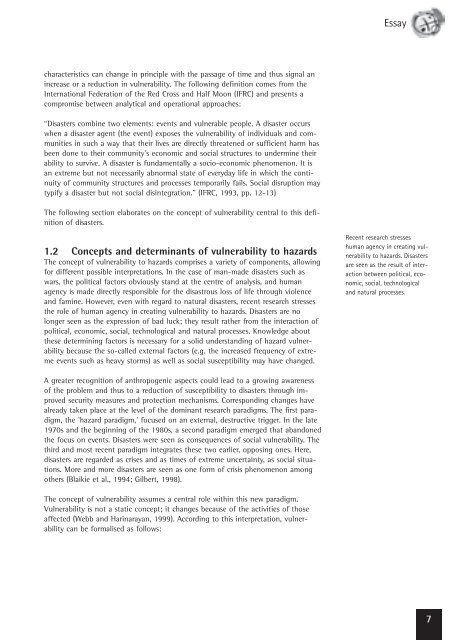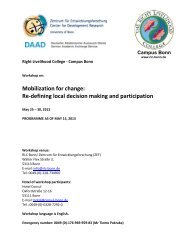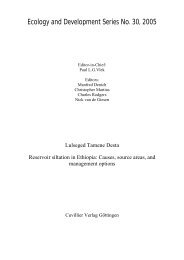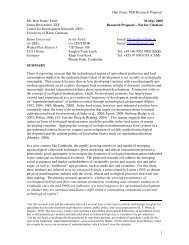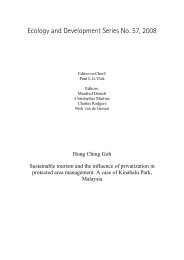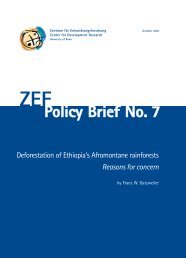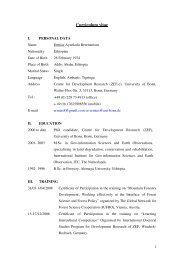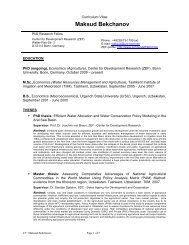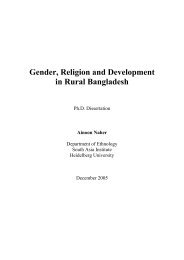ZEF Bonn
ZEF Bonn
ZEF Bonn
You also want an ePaper? Increase the reach of your titles
YUMPU automatically turns print PDFs into web optimized ePapers that Google loves.
characteristics can change in principle with the passage of time and thus signal an<br />
increase or a reduction in vulnerability. The following definition comes from the<br />
International Federation of the Red Cross and Half Moon (IFRC) and presents a<br />
compromise between analytical and operational approaches:<br />
“Disasters combine two elements: events and vulnerable people. A disaster occurs<br />
when a disaster agent (the event) exposes the vulnerability of individuals and communities<br />
in such a way that their lives are directly threatened or sufficient harm has<br />
been done to their community's economic and social structures to undermine their<br />
ability to survive. A disaster is fundamentally a socio-economic phenomenon. It is<br />
an extreme but not necessarily abnormal state of everyday life in which the continuity<br />
of community structures and processes temporarily fails. Social disruption may<br />
typify a disaster but not social disintegration." (IFRC, 1993, pp. 12-13)<br />
The following section elaborates on the concept of vulnerability central to this definition<br />
of disasters.<br />
1.2 Concepts and determinants of vulnerability to hazards<br />
The concept of vulnerability to hazards comprises a variety of components, allowing<br />
for different possible interpretations. In the case of man-made disasters such as<br />
wars, the political factors obviously stand at the centre of analysis, and human<br />
agency is made directly responsible for the disastrous loss of life through violence<br />
and famine. However, even with regard to natural disasters, recent research stresses<br />
the role of human agency in creating vulnerability to hazards. Disasters are no<br />
longer seen as the expression of bad luck; they result rather from the interaction of<br />
political, economic, social, technological and natural processes. Knowledge about<br />
these determining factors is necessary for a solid understanding of hazard vulnerability<br />
because the so-called external factors (e.g. the increased frequency of extreme<br />
events such as heavy storms) as well as social susceptibility may have changed.<br />
A greater recognition of anthropogenic aspects could lead to a growing awareness<br />
of the problem and thus to a reduction of susceptibility to disasters through improved<br />
security measures and protection mechanisms. Corresponding changes have<br />
already taken place at the level of the dominant research paradigms. The first paradigm,<br />
the 'hazard paradigm,' focused on an external, destructive trigger. In the late<br />
1970s and the beginning of the 1980s, a second paradigm emerged that abandoned<br />
the focus on events. Disasters were seen as consequences of social vulnerability. The<br />
third and most recent paradigm integrates these two earlier, opposing ones. Here,<br />
disasters are regarded as crises and as times of extreme uncertainty, as social situations.<br />
More and more disasters are seen as one form of crisis phenomenon among<br />
others (Blaikie et al., 1994; Gilbert, 1998).<br />
The concept of vulnerability assumes a central role within this new paradigm.<br />
Vulnerability is not a static concept; it changes because of the activities of those<br />
affected (Webb and Harinarayan, 1999). According to this interpretation, vulnerability<br />
can be formalised as follows:<br />
Essay<br />
Recent research stresses<br />
human agency in creating vulnerability<br />
to hazards. Disasters<br />
are seen as the result of interaction<br />
between political, economic,<br />
social, technological<br />
and natural processes.<br />
7


